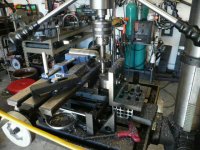robert102653
Aluminum
- Joined
- Apr 21, 2015
- Location
- wilmington nc
I have been looking all over and found roughing reamers and finishing reamers for mt2 holes. yet I have found nothing about actually roughing out the hole itself except to bore the hole on a lathe. Well i do have a lathe SB 9A but the part i need to put this mt2 hole in can not be mounted on my lathe. It is a large jig for making another fixture . My question is is there such a thing as an mt2 drill bit to rough out the hole before reaming? and if not, what is the method i should use to make that rough hole? oh and if there is, what in hell is it called as I have been looking for a tapered drill bit but all i find is tapered shanks when I put the phrase in google or any other place. I have a very large drill press that I could mount this jig on but I need the roughing hole, or the method of how to do that.



